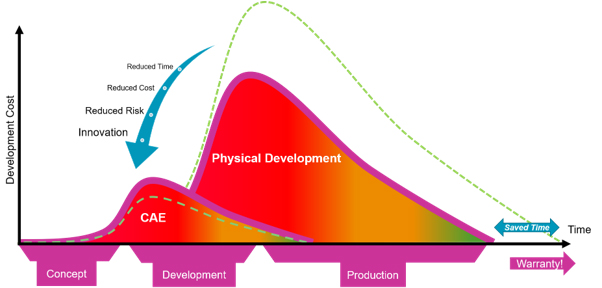
The shift to e-mobility has a profound impact on drive system development. In their efforts to make the transition in a time- and cost-effective way, global manufacturers, OEMs and tier 1s are investing heavily in new technologies, and learning how to overcome new product development challenges.
One area where huge gains can be made is by finding ways to use simulation across the entire development process, not simply within the analysis stage. Using CAE all the way from the initial design, through analysis, right up to manufacturing, ultimately means gaining a better understanding of end product performance in the virtual realm, reducing the need for physical prototyping and saving time and cost, even when exploring innovative designs.
Challenges in electrification and gear design and manufacture
With the design of electric vehicle propulsion systems rapidly evolving, powertrain and component designers and suppliers are constantly encountering new challenges. As systems become more complex and more integrated, many organisations are learning the hard way that finding design issues during manufacture or end-of-line testing is simply too late. There is a risk that unexpected gear issues such as noise and vibration can show up late in the process causing high rejection rates, requiring changes in manufacturing, a major redesign, etc. – all of which can amount to very high costs and long delays.
Gear issues can often be traced back to a design process that has failed to consider the impact of differences in the manufactured geometry. When the actual gear geometry differs from what the designers and analysts based their calculations on, even by a small amount, so will the performance. Failures found too late can result in rejected gearboxes – a waste of time, money, effort, and a missed opportunity to get ahead of the curve and ahead of the competition. And no one is to blame. It is a failure in the process, and an opportunity for improvement.
The disconnect between gear design and gear manufacture
Indeed, it is widely acknowledged that there is a disconnect between design engineers and the production department or supplier, which in some cases can significantly increase development times and costs. Gears are highly sensitive to even micron-level deviations in their system performance. The tooth geometry determined by the design engineer often cannot be produced precisely as specified. Even small adjustments made by the manufacturer due to the limitations or intricacies of the manufacturing method can invalidate the design intent. This is exacerbated by manufacturing variability, which adds further uncertainty.
The impact of gear manufacturability can be severe. If unwanted deviations are found during production, the options to fix this are limited. If the tooling has already been purchased, retooling is expensive and would mean wasted costs on the original tooling. Alternatively, manufacturers can correct for unwanted errors during production, but this can take considerable time, slowing down the production with long cycle times, and requiring additional manufacturing processes as well as specialist tools and machines that can incur significant extra costs. In certain cases, a late-stage redesign may be required which can lead to long project delays.
It is far less expensive and far quicker to resolve these issues during the design stage as opposed to the manufacturing or production stages. However, the design engineer is rarely equipped with the right tools and expertise to consider manufacturing variability at the design stage.
Democratised manufacturing simulation for geared system analysis
Hexagon are working to address this issue, through a recent collaboration between their Romax toolset and Dontyne Systems, intending to create solutions that enable consideration of the manufacturing process at the design stage, without requiring deep gear manufacturing expertise.
The solution sees some of Dontyne’s manufacturing simulation capabilities embedded into Romax products, offering a fully automatable process that can be run as part of parametric studies or in batch mode. Since tooling parameters are automatically estimated based on the designed geometry, it is not necessary to have a deep understanding of gear manufacturing to use it. However, for those expert users who require a little more control, it is possible to view all the details of the tooling and the gear finishing simulation performed by Dontyne and to have more manual control over the settings.
The accurate gear geometry is used for tooth contact analysis, and, by virtue of being fully integrated into Romax, is considered in the context of the full drive system for durability, NVH, and efficiency analysis. Having a full system tool such as Romax at the centre of the design process allows users to get more out of a single model – a model which does not just consider a single component in isolation, but all of the interactions between the key components (shafts, gears, bearings, housings) and the subsequent impact on shaft deflection, gear contact, misalignment, transmission error, etc.
Bearing stiffness calculations form a key part of this analysis, and indeed are a foundational part of Romax’s technology. Bearings are highly non-linear and calculating their stiffness requires consideration of many internal factors (load, manufacturing or mounting clearance, internal details, varying contact angles between the rolling elements and the raceways, mounting fit, temperatures, etc.). However complex, it is critical that bearing stiffness is calculated accurately, since its impact ripples through the whole powertrain system.
The speed of the calculation is also vital: Romax achieves its orders of magnitude faster analysis times through a combination of finite element, analytical and empirical methods, using the most computationally efficient and most accurate method for every part, and combining them into a fully coupled system simulation. This gives the best of everything – a blend of speed and accuracy, specifically optimised for powertrain simulation. Dontyne’s analytical methods fit perfectly into this methodology and generate accurate manufacturable gear geometry in seconds, enabling for example system parametric studies in Romax software.
The combination of Romax’s powerful full system simulation and Dontyne’s advanced gear machining simulation unlocks the ultimate value of giving users the confidence that the supplier can make the gears they have designed. As well as having the technology embedded in Romax, it is also possible to export gear sets from Romax and open these in the full version of Dontyne’s Machine Centre, which will enable Romax users to directly provide data to gear manufacturers who use Machine Centre for the detailed tooling design and other manufacturing aspects. Better collaboration between these teams enables problems to be identified and adjustments made before commitment to machining.
Wider vision for the role of simulation in geared system development
Dontyne have developed their software with openness and full appreciation of the importance of partnerships and were thus well suited to join Hexagon’s comprehensive partner ecosystem. The collaboration between these two partners is a great step forward for both parties and for the companies and industries they serve. There are additional plans to not only provide new technological capabilities but with a wider vision to improve industry practices for the development and production of geared electro-mechanical drive systems.
Having put more consideration for gear manufacturing into drivetrain CAE with Romax software and the partnership with Dontyne, Hexagon are also working to extend the digital thread offered by simulation towards physical manufacturing and metrology. Gear measurements provide very useful data about the achieved gear profiles, which can be fed directly into full system simulation models like the ones used for design and analysis earlier in the process.
These gear measurements are traditionally evaluated using industry standards that can classify the quality achieved in a single gear. However, the same measurements with little to no additional effort can be combined and fed into a simulation model of an entire powertrain system. This opens up possibilities to evaluate the measured parts in a virtually assembled state and obtain much more than a quality grade. A simulation model can easily provide, for example, gear contact patterns, transmission error, micro-geometry-based efficiency, and even acoustic radiation. This means that today’s component measurement processes can be significantly augmented through simulation to give far deeper insight into system performance before sub-system and system testing, increasing the value and utilisation of measurement systems and reducing the risk further down the line.
The main challenges in achieving this vision are related to the integration of different systems and areas of knowledge that typically have little to no interaction due to their place in the product development process, like for example gear design and analysis and gear production. As part of Hexagon and in partnership with Dontyne, the team behind Romax is now able to collaborate closely with experts in manufacturing, metrology and Quindos to research and develop the necessary capabilities.
Immense knowledge and expertise are focused on developing targeted tools with an understanding of the specific needs and constraints at every stage of geared electro-mechanical system development and production with the ultimate goal of accelerating industry innovation and manufacturers’ ability to bring quality products to market faster and more affordably.
By Kristian Kouumdjieff, Product Manager Romax Enduro, Hexagon
